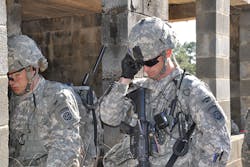DARPA seeks to ensure radio networking reliability in jamming and interference
ARLINGTON, Va. - Officials of the U.S. Defense Advanced Research Projects Agency (DARPA) in Arlington, Va., have issued a presolicitation (HR001118S0012) for the Network Universal Persistence (Network UP) project to develop and demonstrate radio technology that maintains network reliability through periods of frequent signal degradation that routinely occur during military operations.
The DARPA Network UP project is trying to maintain military radio communications and networking amid enemy jamming and interference.
The project seeks to maintain network reliability by separating control information and communications data in separate wireless links to create a protected control channel that can maintain network reliability even when the data channel is lost. A significant problem with many of today's military wireless networks involves periodic network outages due to brief losses of wireless links outages. This loss of network connectivity that can take more than two minutes to recover once the wireless link is re-established. Moreover, networks in dynamic wireless environments can end up mostly attempting to establish the network rather than sending data.
Today's military radios send the network control information and the data using the same wireless link, which causes a network failure when that wireless link degrades. Separating the control and data information across two different wireless links should enable developers to use the relatively low bit rate of the control information and match the control link frequency to the environment to create a robust control link that can withstand degradation of tens of decibels, researchers say.
Maintaining the network via a robust control channel should enable the network to send data over the network immediate as soon as the link is available.
The three-year Network UP program seeks to develop prototypes that enable military wireless networks to send data over unstable wireless links. The program's first phase has two parts: developing a radio architecture that separates control and data channels; and developing a bursty link network that exploits burst or transient links.
Radio architectures and waveforms should be able to operate the control channel through deep and periodic data channel degradation, with an eye toward developing an applique to improve the performance of legacy radios.
The project's second part will develop a scalable control plane that resides in a separate RF band from the data plane, and develop an ability for the control to send essential mission information when the data channel is not available.
Demonstrations in the project's second phase will integrate the Network Up control radio with a legacy radio as the data radio; evaluate performance in urban, dense-foliage, and jamming conditions; and integrate a Network UP control radio applique with a legacy radio with significant performance improvement.
More information is online at http://bit.ly/2s2FnKG.

